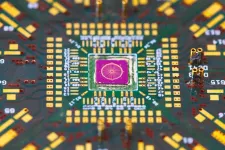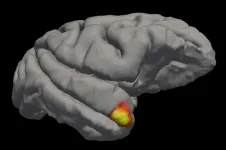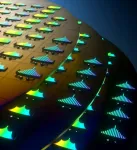Unfinding a split electron
Scientists advance the understanding of potential topological quantum bits
2021-07-01
(Press-News.org) Quantum computers promise great advances in many fields - from cryptography to the simulation of protein folding. Yet, which physical system works best to build the underlying quantum bits is still an open question. Unlike regular bits in your computer, these so-called qubits cannot only take the values 0 and 1, but also mixtures of the two. While this potentially makes them very useful, they also become very unstable.
One approach to solve this problem bets on topological qubits that encode the information in their spatial arrangement. That could provide a more stable and error-resistant basis for computation than other setups. The problem is that no one has ever definitely found a topological qubit yet.
An international team of researchers from Austria, Copenhagen, and Madrid around Marco Valentini from the Nanoelectronics group at IST Austria now have examined a setup which was predicted to produce the so-called Majorana zero modes - the core ingredient for a topological qubit. They found that a valid signal for such modes can in fact be a false flag.
Half of an Electron
The experimental setup is composed of a tiny wire just some hundred nanometers - some millionths of a millimeter - long, grown by Peter Krogstrup from Microsoft Quantum and University of Copenhagen. These appropriately-called nanowires form a free-floating connection between two metal conductors on a chip. They are coated with a superconducting material that loses all electrical resistance at very low temperatures. The coating goes all the way up to a tiny part left at one end of the wire, which forms a crucial part of the setup: the junction. The whole contraption is then exposed to a magnetic field.
The scientists' theories predicted that Majorana zero modes - the basis for the topological qubit they were looking for - should appear in the nanowire. These Majorana zero modes are a strange phenomenon, because they started out as a mathematical trick to describe one electron in the wire as composed of two halves. Usually, physicists do not think of electrons as something that can be split, but using this nanowire setup it should have been possible so separate these "half-electrons" and to use them as qubits.
"We were excited to work on this very promising material platform," explains Marco Valentini, who joined IST Austria as an intern before becoming a PhD student in the Nanoelectronics group. "What we expected to see was the signal of Majorana zero modes in the nanowire, but we found nothing. First, we were confused, then frustrated. Eventually, and in close collaboration with our colleagues from the Theory of Quantum Materials and Solid State Quantum Technologies group in Madrid, we examined the setup, and found out what was wrong with it."
A False Flag
After attempting to find the signatures of the Majorana zero modes, the researchers began to vary the nanowire setup to check whether any effects from its architecture were disturbing their experiment. "We did several experiments on different setups to find out what was going wrong," Valentini explains. "It took us a while, but when we doubled the length of the uncoated junction from a hundred nanometers to two hundred, we found our culprit."
When the junction was big enough the following happened: The exposed inner nanowire formed a so-called quantum dot - a tiny speck of matter that shows special quantum mechanical properties due to its confined geometry. The electrons in this quantum dot could then interact with the ones in the coating superconductor next to it, and by that mimic the signal of the "half-electrons" - the Majorana zero modes - which the scientists were looking for.
"This unexpected conclusion came after we established the theoretical model of how the quantum dot interacts with the superconductor in a magnetic field and compared the experimental data with detailed simulations performed by Fernando Peñaranda, a PhD student in the Madrid team," says Valentini.
"Mistaking this mimicking signal for a Majorana zero mode shows us how careful we have to be in our experiments and in our conclusions," Valentini cautions. "While this may seem like a step back in the search for Majorana zero modes, it actually is a crucial step forward in understanding nanowires and their experimental signals. This finding shows that the cycle of discovery and critical examination among international peers is central to the advancement of scientific knowledge."
INFORMATION:
[Attachments] See images for this press release:

ELSE PRESS RELEASES FROM THIS DATE:
2021-07-01
Current rates of plastic emissions globally may trigger effects that we will not be able to reverse, argues a new study by researchers from Sweden, Norway and Germany published on July 2nd in Science. According to the authors, plastic pollution is a global threat, and actions to drastically reduce emissions of plastic to the environment are "the rational policy response".
Plastic is found everywhere on the planet: from deserts and mountaintops to deep oceans and Arctic snow. As of 2016, estimates of global emissions of plastic to the world's lakes, rivers and ...
2021-07-01
Scientists have long searched in vain for a class of brain cells that could explain the visceral flash of recognition that we feel when we see a very familiar face, like that of our grandmothers. But the proposed "grandmother neuron"--a single cell at the crossroads of sensory perception and memory, capable of prioritizing an important face over the rabble--remained elusive.
Now, new research reveals a class of neurons in the brain's temporal pole region that links face perception to long-term memory. It's not quite the apocryphal grandmother neuron--rather than a single ...
2021-07-01
The COVID-19 catastrophe in India has resulted in more than 30 million people infected with the virus and nearly 400,000 deaths, though experts are concerned that the figures most likely are much higher. Meanwhile, another public health crisis has emerged along with COVID-19: the widespread misuse of antibiotics.
During India's first surge of COVID-19, antibiotic sales soared, suggesting the drugs were used to treat mild and moderate cases of COVID-19, according to research led by Washington University School of Medicine in St. Louis. Such use is considered inappropriate because antibiotics are only effective against bacterial infections, not viral infections such as COVID-19, and overuse increases the risk ...
2021-07-01
Fifteen years ago, UC Santa Barbara electrical and materials professor John Bowers pioneered a method for integrating a laser onto a silicon wafer. The technology has since been widely deployed in combination with other silicon photonics devices to replace the copper-wire interconnects that formerly linked servers at data centers, dramatically increasing energy efficiency -- an important endeavor at a time when data traffic is growing by roughly 25% per year.
For several years, the Bowers group has collaborated with the group of Tobias J. Kippenberg at the Swiss Federal Institute of Technology (EPFL), within the Defense Advanced Research Projects Agency (DARPA) Direct On-Chip Digital Optical ...
2021-07-01
Optical frequency combs consist of light frequencies made of equidistant laser lines. They have already revolutionized the fields of frequency metrology, timing and spectroscopy. The discovery of ''soliton microcombs'' by Professor Tobias Kippenberg's lab at EPFL in the past decade has enabled frequency combs to be generated on chip. In this scheme, a single-frequency laser is converted into ultra-short pulses called dissipative Kerr solitons.
Soliton microcombs are chip-scale frequency combs that are compact, consume low power, and exhibit broad bandwidth. Combined with large spacing of comb "teeth", microcombs are uniquely ...
2021-07-01
Conversations between seriously ill people, their families and palliative care specialists lead to better quality-of-life. Understanding what happens during these conversations - and particularly how they vary by cultural, clinical, and situational contexts - is essential to guide healthcare communication improvement efforts. To gain true understanding, new methods to study conversations in large, inclusive, and multi-site epidemiological studies are required. A new computer model offers an automated and valid tool for such large-scale scientific analyses.
Research results on this model were published today in PLOS ONE.
Developed by a team of computer scientists, clinicians and engineers at the University of Vermont, the approach - called CODYM ...
2021-07-01
A study by Stanford University School of Medicine investigators hints that people with COVID-19 may experience milder symptoms if certain cells of their immune systems "remember" previous encounters with seasonal coronaviruses -- the ones that cause about a quarter of the common colds kids get.
These immune cells are better equipped to mobilize quickly against SARS-CoV-2, the coronavirus responsible for COVID-19, if they've already met its gentler cousins, the scientists concluded.
The findings may help explain why some people, particularly children, seem much more resilient than others to infection by SARS-CoV-2, the coronavirus that causes COVID-19. They also might make it possible ...
2021-07-01
Scientists have developed a new technology to detect a wider variety of T cells that recognize coronaviruses, including SARS-CoV-2. The technology revealed that killer T cells capable of recognizing epitopes conserved across all coronaviruses are much more abundant in COVID-19 patients with mild disease versus those with more severe illness, suggesting a protective role for these broad-affinity T cells. The ability to distinguish T cells based on their affinities to SARS-CoV-2 could help scientists elucidate the disparity in COVID-19 outcomes and determine which COVID-19 patients will or will not exhibit a successful immune response ...
2021-07-01
In a new Editorial, Peter Heeger, Christian Larsen, and Dorry Segev discuss recent evidence - including a recent Science Immunology study by Hector Rincon-Arevalo and colleagues - that points to a diminished immune response to COVID-19 vaccines among organ transplant recipients and others on immunosuppressive drug regimens. The authors note that this presents challenges at both the individual and population levels, since current vaccine protocols may not provide adequate protection to immunosuppressed patients - who could, in turn, become reservoirs for new and dangerous variants of the virus. As such, Heeger, Larsen, and Segev argue that developing vaccination strategies for transplant recipients should be a high priority in the next wave of research focused on fighting COVID-19. ...
2021-07-01
ROCHESTER, Minn. -- Research by investigators at Mayo Clinic Cancer Center suggests that physicians should screen patients with lung cancer for MET amplification/overexpression before determining a treatment strategy. Their findings are published Cancer Discovery, a journal of the American Association for Cancer Research.
"In our research we found several lung cancer cases that were not responsive to standard chemotherapy," says Zhenkun Lou, Ph.D., a cancer researcher at Mayo Clinic. "Because these lung cancers were positive for PD-L1, a protein that allows some cells ...
LAST 30 PRESS RELEASES:
[Press-News.org] Unfinding a split electron
Scientists advance the understanding of potential topological quantum bits




